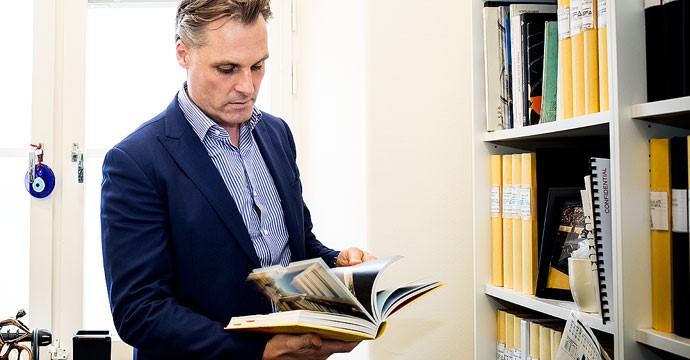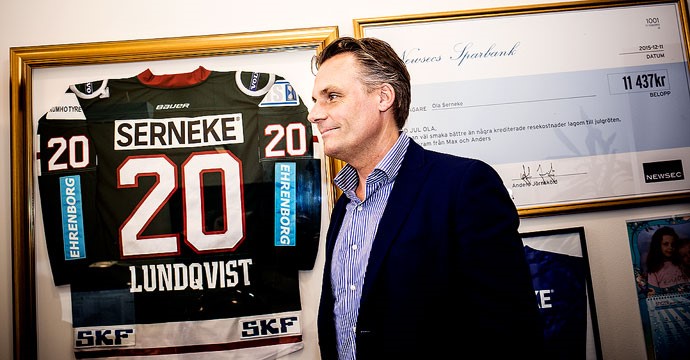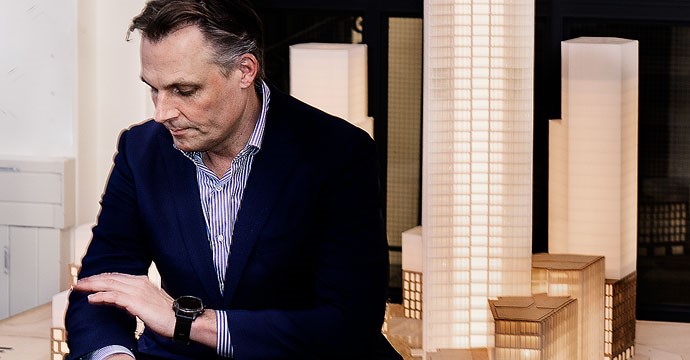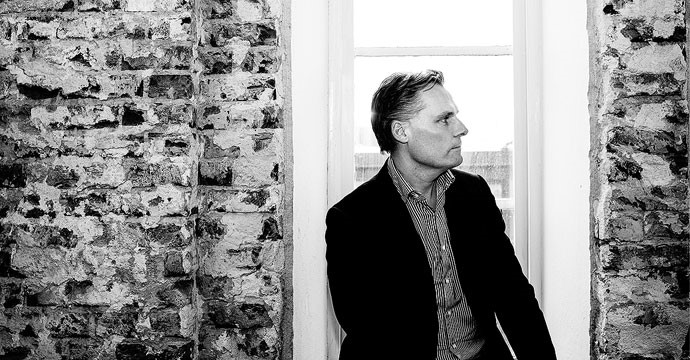"I'm never satisfied"
In 2030, Serneke will be one of the world's 30 largest construction companies. Impossible? "Not at all, we are completely on track" says Ola Serneke, who sees his staff as the company's greatest asset.
From Ola Serneke’s office the view is magnificent. On the other side of the river you see the place where Karlatornet, Gothenburg's new flagship building, will be ready in just a few years. The cranes in the port that commemorate the city's history as an industrial city will also, at least for the foreseeable future, remain in place. Ola Serneke, Stena Line and Volvo have committed to this. After encouragement from the TV profile Ingvar Oldsberg, the companies joined forces, bought the cranes and donated them to the municipality with a promise that they would be left where they stand.
But Ola Serneke himself has no time to look at the view. Not at the moment anyway. He has important business to complete. It is not only the office that has changed since I visited Serneke five years ago. The company is now listed on the NASDAQ Stock Exchange in Stockholm, the number of employees has more than doubled and the turnover is more than three-fold higher. Ola Serneke’s ambition that the company will become one of the largest construction companies in Sweden is about to be realized. It took nine years for the company that bears its founders ' family name from 2002 to qualify for the Swedish construction industry's list of the 30 largest English translation. Industry companies in Sweden. Now Serneke is in ninth place and the goal is to climb further.
"It's fun to succeed, and although we've had high targets according to some, they have always been reasonable goals, I think", says Ola Serneke.

The book "How houses were built 1880 – 2000 – Architecture, construction and materials in our apartment buildings over 120 years" can be found in Ola Serneke’s bookshelf. He looks at it at times. "Each period of time has its architecture. It is the change that is interesting. " Photo: Maja Nylander
The key to success lies in committed staff who have an opportunity to evolve, according to Ola Serneke himself.
"This means that we get people who are committed and want to give a little extra. It is important that employees have the opportunity to develop themselves personally as well as their education, experience and health.”
The way to success has involved interesting and fun projects: Gothenburg's first real skyscraper Karlatornet and the district of Karlastaden; the Nordic region's largest multi-sport arena Priority Serneke Arena, but also projects such as Sweden's largest solar cell park at the airport in Gothenburg, Partille Kultura, Fjätervålens Mountain facility, and the renovation of the Stockholm City Museum, to name a few of the hundreds of projects that the company has implemented or is currently working with.
"These are not projects that are traditional, boring, monotonous, or repetitive. We dare to take on ever-bigger and more challenging projects.”
Why is it important to be one of the biggest?
"Because you can have a positive impact on society. To be in a position where people listen to us and so we can be part of changing the social image.”
The largest multi-sport arena in Kviberg, which Serneke has built and partly owns, is one such project, according to Ola Serneke. The stadium, which bears the name Priority Serneke Arena, opened in July 2015.
"It has actually changed a whole district and created new associations and new clubs for the public. The local secondary and primary school is now one of the best in Sweden, from having been one of the worst. It has attracted lots of young people to start skiing.”
Where does your driving force come from?
"My mum was very committed to everything when she was still alive. She was, among other things, chairman of Amnesty. My father is the same. I think I have a lot of my family's attitude towards life. I think it is important that we who are entrepreneurs take a social responsibility and do something that is good for society.”
Several of the goals that Ola Serneke set for the company have already been achieved. According to the business plan that was set in 2009, all goals have been fulfilled. The goal from the start in 2002 “to turnover SEK 1 billion within ten years” was ramped up to a turnover target of 10 billion kronor by 2020. But being among the largest in Sweden is not enough. Serneke wants the group to belong to the 30 largest construction companies in the world by 2030. Bold? Definitely. Impossible? Not according to Ola himself.
This requires a turnover of SEK 60 billion.
How is this to be achieved?
"By continuing to grow organically and through good acquisitions. There will be better opportunities now that economic activity is slowing. There will be companies that are forced to sell when there is economic instability and uncertainty. We will be there to help them.”
According to Ola, Serneke has always seen opportunities in crises.
"We have managed crises really well. That is when we see opportunities to expand. Suddenly there are more people to get hold of, you can get better purchase prices and make acquisitions. We have always positioned ourselves better during different crises because we have actively chosen the right customers, such as the state and municipality as well as larger companies that are not so cyclically sensitive.”
Do you see any risks in a recession?
"Everything is relative. It depends on what you mean by a recession. Rather, I think it is a question of normal economic activity. There is a lot of building going on. A real recession is like in the 1990s. Then everything stopped and nothing happened. Now we still have a great need for social properties that are missing and need to be built, so there will not be a recession in that respect. However, we will not be building a lot of expensive condominiums, and that is a huge difference. It is good for everyone that things have calmeddown.”
“Now the country is open. In markets that have been difficult to engage in due to the boom and rising wages, it has been hard to attract talented employees, but opportunities are now opening up.”
"You can make good money on government contracts now. We will, among other things, put more firepower on the infrastructure side, where we are also broadening our rail projects, and we are investing in taxpayer projects such as schools, sports halls and offices when the housing side folds down. I believe in that combination. I feel confident in our expansion and continued development.

Serneke sponsors both large and small sports clubs. The hockey team Frölunda Indians and IFK Göteborg belong to the larger clubs that are visible in the country's arenas with Serneke’s names on the shirts. Photo: Maja Nylander
Serneke can largely be seen as a success story. The strategy of clear growth targets has proven to be profitable as well. In the annual accounts for 2018, the company made a positive operating profit of SEK 595 million, with a margin of 9.1 percent. Revenue increased by 16 percent in the full year.
On August 1, 2012 the first sod was turned for the Priority Serneke Arena in Kviberg. If Ola Serneke points to any individual deal that has been decisive for the company's success, it is the multi-sport arena.
"It was a game-changers. Both financially but also emotionally. That was the turnaround. There were so many people who did not think we could do it; back then we were a very small company, but we solved it well in terms of results and outcome, and it has had very, very positive feedback since. We showed to employees and customers that we could do something that many might not have thought we could manage, so I'm proud of that. It is a project that has affected a whole district positively and it became a very good project financially for us. Good in every way. It's awesome!
What does Serneke do that other companies don’t?
"I think we're trying to twist and turn everything for it to be good. I think we are good at that. We dare to question and look at things in a different way. Our whole organisation is based on our being courageous and avalues-driven company. We are a company of flesh and blood, we do not build by the book. We will be genuine, honest and courageous, dare to question and see opportunities in everything we do.”
Ola Serneke’s office on the third floor of the head office at Kvarnbergsgatan 2 in Gothenburg is certainly quite typical for a CEO of a listed company. A desk, a sitting table, a bookcase with various things, mostly files, but also books on architecture, pictures of the children on the walls. What possibly stands out is several framed hockey jerseys from the teams that the company sponsors.

The future tallest building of the Nordic region, Karlatornet at Lindholmen in Gothenburg, was seen by many as a grandiose vision a number of years ago. But in three years time, the 245 meter skyscraper will be completed and occupied. Photo: Maja Nylander
A portrait photo of Ola Serneke himself in profile is leaning against a wall. Tucked into the frame, a different profile picture is inserted. – “Is it your dad?” asks photographer Maja Nylander.
“Haha! No, it is Tito (Dictator of the former Yugoslavia, Ed). It’s from one of our managerswho siad I was just like him when we were kidding around the other day.”
What kind of leader are you?
"I want to make things go forward. I push - sometimes I push maybe a little too hard. I see opportunities in most things and try to get my employees into the same view. I am positive.”
How do you think your closest associates would describe you?
"In a similar way, I think. On to things. Stubborn. I do not tolerate a no if it is not well-substantiated and thought out. I need to be convinced.
What the competitors say about Ola Serneke he’d rather not say, other than...
"I'm probably seen as a little sassy.”
Have you faced big challenges at some point?
"Oh yes, it has to be done in a company's life. Now it was many years ago last. But during the expansion in 2008 – 2010 we had some organizational problems and some projects where we did not have the right crew. We were unable to recognize the problems soon enough, and it was a mistake that cost money. Now we are much better equipped for this and have built up support functions that can help in such situations or ensure that they do not occur.”
Why are profits low in construction compared to other industries?
“Well, are they really? One can turn to the question: what is the right level? I think that 4 – 5% on the production side is quite right. Should we earn so much more? The prices of accommodation are quite high anyway.”
If you weren't the CEO of a listed construction company, what would you be then?
"I would probably have had a company. I'm interested in most things. It really became construction from pure coincidence.”
Already during the study period at Chalmers in the 1990s, Ola Serneke had a number of companies. He distinguished himself well in some way. Hans Trulsson, personnel manager at Peab at the time, called up and offered him jobs after graduation.
"It was fun of course.”
Although it is many years since Ola Serneke finished at Peab, he and Hans Trulsson stay in contact. "We have good chemistry.”
It is often said that it is lonely at the top. Is that the case for you?
“Oh no, lonely it is not, the gods will know. I have the board and four subsidiaries- CEOs that I constantly talk to, so it's not that I sit and wait for people to come and knock on my door.”
Ola Serneke remained at Peab for six years before deciding to go out on his own in 2002. The company he started was called Sefa, but after a few years the marketing department wanted to find a better, less anonymous, name. The marketing department hired an advertising agency.
“When they presented their proposal to me, my first thought was: "Never in my life, it's ridiculous that the company should be named after me.” ‘But then I agreed to it, providing customers, suppliers and employees thought it was okay.”
The marketing agency conducted a "mega" survey among customers and employees and almost everyone thought it was just right, says Ola Serneke. "So we went with it. It was that simple.”
What significance has the name change had, do you think?
"It becomes very personified of course. Which is both positive and negative. The company is very linked to me, even if it is not, for better or worse.”
Does the company stand and fall with you?
“No, not a chance. Absolutely not. Not today. Previously it might have been.”
Has marketing played any part in creating a name for you and the company?
“Absolutely! Marketing is extremely important. We want to recruit people for the long term and we want to have customers believe in us and that we are the right contractor for them - and suppliers to believe that we are the right customer for them.”
How do you work with marketing?
"We have a whole department working on this, with plans and strategies. We want to be an attractive company by, among other things, prioritizing health over parties. We do not want to be a company that you associate with a party on Thursday and a hangover on Friday, which has often been the case in the construction industry historically. It does not exist here. It is absolutely not on. We have a smoking ban in the workplace. And we have a lot of sports and health activities. We prioritize this in our marketing.”
Is attracting the right personnel the main purpose of your marketing?
"Attractiveness consists of so many different parameters. First, you should of course have projects that are interesting, which attracts people. And then you get good people, which attracts more good people - and the wheels start to spin in the right direction. Good managers, management and governance – all founded on good core values that are genuine and not just for the sake of it – are important.
Brand building is a long-term process. In the end, one strengthens the other. With the right staffing, you can win and run large and spectacular projects – and the company’s brand becomes even better known. Although not without the wondering which comes first – good reputation or good work – it’s a bit like the chicken and the egg.
In Gothenburg, there is hardly any single person who is unaware of Karlatornet, which Serneke is building in Hisingen, the old dock area of Gothenburg. The 245-meter-high tower with 73 floors will be Gothenburg's first skyscraper and the Nordic region's tallest building to date. The building has in fact also been designed by architectural firm Skidmore, Owings & Merrill, which is behind some of the highest and most spectacular buildings in the world, including the Burj Khalifa and the One World Trade Center in New York.
What does it mean to build a flagship building such as a Karlatornet in marketing terms?
"It's a typical project that suits us as a company. We like to take on projects that are challenging – and this is challenging if anything. It means very much, of course, for our brand that we first built the largest multi-sport facility in the Nordic region, which people doubted at first, just as with Karlatornet in the beginning, but that only gives us added motivation to prove ourselves.
Karla tower will be ready for occupancy in 2021 and should be fully occupied in 2022. The tower includes 600 apartments, so it will take its time to move in. Eventually, Serneke’s headquarters will also move there.
There is no doubt that the tempo is high and the days long for this construction. At 5am he rises with a big coffee in hand. An hour later he is at work. Often first in place. His working day is typically 13-14 hours. Mostly revolving around the job. He’s on call 24 hours a day. But Ola Serneke says he has no need to relax.
Sport, however, he likes. Sports with speed. Enduro, mountain biking and cross-country skiing above all. As a child, he was considered wild. Totally fearless. To plunge out and speed up the bike whether he knew what it was like beyond the crest or not. Perhaps it is a property that continues to work as a business leader.

Ola’s personal goals are to be more active and see his kids more often. Photo: Maja Nylander
That fearlessness has left its mark. Both large and small physical scars. But still, soon to turn 48 and perhaps in the midst of life, the allure of speed remains, even if thoughts of what is around the corner are starting to sneak into his head as he swoops through life. Even for Ola Serneke, a sense of mortality has started to emerge. It is compelling to reflect on children and responsibility.
As a business executive, Ola Serneke also has another approach to sport. His company is, due to his own initiatives, the largest sponsor of sports clubs in Sweden relative to the company's size. How much Serneke actually spends on sponsorship, he does do not want to say. The company sponsors, amongst others, the major teams IFK Göteborg and Frölunda Indians, but also approximately 130 smaller associations. Sponsorship is also an important part of the company's marketing efforts.
Why is sponsorship important?
"Companies play a very important role in Sweden. We who are entrepreneurs must take responsibility for our community and be part of it. Sweden's population has risen by 2 million since the 80s. The state and the municipality wasn’t prepared for that and we will try to help. Sponsorship is also a way to create pride, participation and commitment among employees in their own company. Serneke has a policy to sponsor all clubs and societies in which our employees are active in some way.
"It gives a lot of back. Employees who thrive and are engaged create a good culture, positively affecting the results of their work.”
After just over half an hour's talk at Ola Serneke’s office, I understand that he has other things to do, business to finish, much to administer. Is there time for rest? Well, not right away. Nor to rest on former successes.
"I'm always on my way to the next. I am never satisfied, perhaps you could say.”
Current news
- 12/06/2023 Doxa calls for compulsory redemption and Serneke applies for delisting
-
16/03/2023
Serneke to construct train depot in Falköping
Serneke has signed a contracting agreement with Intea Fastigheter AB (publ) to build a new train dep...;
-
12/01/2023
Serneke to build 129 apartments in Lund
Serneke has signed a turnkey contract with municipal housing company LKF in the university city of L...;
-
4/01/2023
Serneke is rebuilding the Viskan prison in the Municipality of Ånge
Serneke has signed a contracting agreement with Intea Bygg AB for the rebuilding of the Viskan corre...;
-
11/11/2022
Serneke to construct new court building in Vänersborg
Serneke and Hemsö Fastigheter AB have signed a turnkey contract regarding new premises for the Väner...;
-
11/11/2022
Top apartment in Karlatornet sold at record price
The second of the two top-level apartments in the Karlatornet tower has now been sold. For the purch...;
Press releases
- 21/06/2023 Serneke's application for delisting has been approved and the Board of Directors has resolved not to publish the interim report for the second quarter of 2023
-
14/06/2023
Notice to attend the Extraordinary General Meeting of Serneke Group AB (publ)
Shareholders of Serneke Group AB (publ) ("Serneke") or ("the Company"), corporate identity number 55...
-
25/05/2023
Interim report January-March 2023
STABLE IN A SHRINKING MARKET